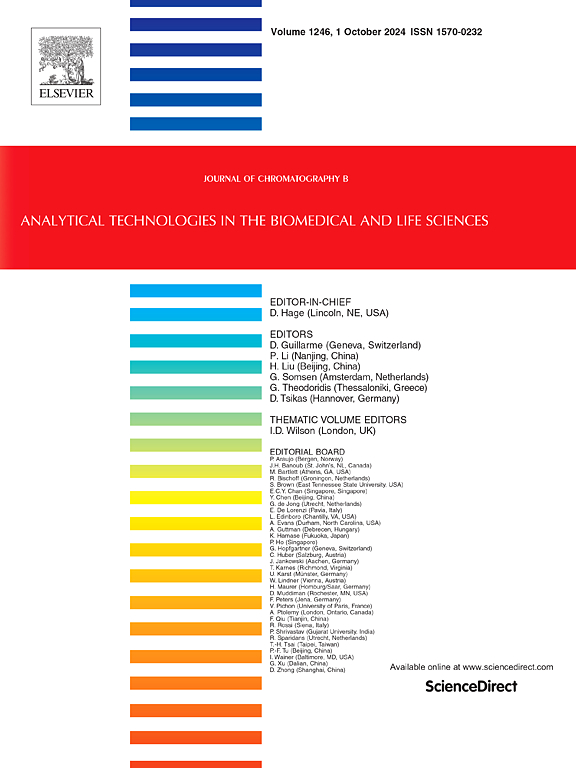Separation and enrichment of fingolimod and citalopram active drug ingredients by fabric phase sorptive extraction followed by high performance liquid chromatographic analysis with diode array detection
IF 2.8
3区 医学
Q2 BIOCHEMICAL RESEARCH METHODS
引用次数: 0
Abstract
Multiple Sclerosis (MS) is a chronic disorder affecting the central nervous system. The treatment of MS often involves a combination of pharmaceutical agents, including Fingolimod (FIN) and Citalopram (CIT). The analysis of these drug compounds plays a crucial role in various stages of health sciences, ranging from drug development to therapeutic monitoring. In this study, a rapid and sensitive analytical method was developed for the trace determination of FIN and CIT using fabric phase sorptive extraction (FPSE) as a sample pretreatment technique, followed by high-performance liquid chromatography coupled with diode array detection (HPLC-DAD). Key FPSE parameters—including pH, adsorption and desorption conditions, and extraction time—were systematically optimized. Analytical performance characteristics of the proposed method were evaluated under optimized conditions in accordance with international guidelines. Chromatographic separation of FIN and CIT was achieved via isocratic elution using a mobile phase composed of acetonitrile, pH 3.0 phosphate buffer, and methanol (50:40:10, v/v/v) at a flow rate of 1.0 mL min−1. The limits of detection (LOD) for FIN and CIT were determined to be 7.46 ng mL−1 and 5.97 ng mL−1, respectively. The method demonstrated good precision, with relative standard deviation (RSD) values below 6.0 % for spiked samples. Recovery rates from synthetic urine and saliva matrices ranged between 93.1 % and 105.0 % for both analytes, confirming the method's accuracy and applicability to biological samples.
采用织物相吸附萃取-高效液相色谱二极管阵列检测分离富集芬戈莫德和西酞普兰活性药物成分
多发性硬化症(MS)是一种影响中枢神经系统的慢性疾病。多发性硬化症的治疗通常涉及药物制剂的组合,包括芬戈莫(FIN)和西酞普兰(CIT)。这些药物化合物的分析在健康科学的各个阶段起着至关重要的作用,从药物开发到治疗监测。本研究采用织物相吸附萃取(FPSE)作为样品前处理技术,再结合高效液相色谱-二极管阵列检测(HPLC-DAD),建立了一种快速、灵敏的微量FIN和CIT的分析方法。系统优化了FPSE关键参数,包括pH、吸附和解吸条件、萃取时间。在符合国际标准的优化条件下,对该方法的分析性能进行了评价。采用乙腈、pH为3.0的磷酸盐缓冲液和甲醇(50:40:10,v/v/v)组成的流动相,流速为1.0 mL min - 1,进行等密度洗脱,实现FIN和CIT的色谱分离。FIN和CIT的检测限(LOD)分别为7.46 ng mL - 1和5.97 ng mL - 1。该方法精密度高,加标样品的相对标准偏差(RSD)小于6.0%。合成尿液和唾液基质的回收率在93.1% ~ 105.0%之间,证实了该方法的准确性和对生物样品的适用性。
本文章由计算机程序翻译,如有差异,请以英文原文为准。
求助全文
约1分钟内获得全文
求助全文
来源期刊

Journal of Chromatography B
医学-分析化学
CiteScore
5.60
自引率
3.30%
发文量
306
审稿时长
44 days
期刊介绍:
The Journal of Chromatography B publishes papers on developments in separation science relevant to biology and biomedical research including both fundamental advances and applications. Analytical techniques which may be considered include the various facets of chromatography, electrophoresis and related methods, affinity and immunoaffinity-based methodologies, hyphenated and other multi-dimensional techniques, and microanalytical approaches. The journal also considers articles reporting developments in sample preparation, detection techniques including mass spectrometry, and data handling and analysis.
Developments related to preparative separations for the isolation and purification of components of biological systems may be published, including chromatographic and electrophoretic methods, affinity separations, field flow fractionation and other preparative approaches.
Applications to the analysis of biological systems and samples will be considered when the analytical science contains a significant element of novelty, e.g. a new approach to the separation of a compound, novel combination of analytical techniques, or significantly improved analytical performance.
 求助内容:
求助内容: 应助结果提醒方式:
应助结果提醒方式:


